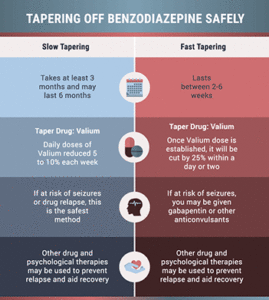Benzodiazepines are a class of sedative drugs that treat anxiety, from generalized anxiety disorders, anxiety associated with depression, and conditions like insomnia and seizures. Since they primarily treat anxiety disorders, they are one of the most widely prescribed groups of medications in the United States. Benzodiazepines like Xanax, Valium, and Ativan may also be administered along with anesthesia before surgeries, to help the anesthesia take effect and calm any nervousness about the procedure.
Medications in the benzodiazepine class work on the gamma-Aminobutyric (GABA) receptors in the brain, allowing the GABA neurotransmitter to be more bioavailable. GABA slows down the communication between neurons. When neurons fire too rapidly, panic attacks or seizures can result, depending on how severe the GABA deficit is.
How Can a Clinician Taper Patients From Benzodiazepine Dependence Safely?
Since there are physical risks with benzodiazepine withdrawal, the tapering process will be designed to slowly decrease your dose over several weeks or months. If you took a benzodiazepine like Klonopin, Ativan, or Xanax as prescribed, your doctor will start cutting your dose every few days or weeks until your body is no longer dependent on the drug. It is important to attend behavioral therapy alongside consistent benzodiazepine use to manage symptoms of anxiety or insomnia that may be triggered by stress.
For doctors who are helping their patients taper off benzodiazepines, there are two general tapers: fast and slow.
Fast Tapering
This rapid process lasts for between two and six weeks, with consistent monitoring of withdrawal symptoms to manage how much the dose will be decreased. Your doctor may prescribe diazepam (Valium) as a replacement, and start you on a smaller dose taken one or two times daily. Valium is a longer-acting benzodiazepine than other prescribed benzodiazepines, such as Xanax.
Once the dose of Valium or another benzodiazepine is established, it will be cut by 25 percent within a day or two. Then, your withdrawal symptoms will be monitored at a one-week follow-up visit. If you are at risk of developing a seizure disorder, you may receive a prescription for an anticonvulsant like gabapentin or carbamazepine. You may also receive clonidine, buspirone, a sleep aid, or an antidepressant.
Your doctor will cut your dose of Valium by a quarter once daily for one to two weeks. Your dose of diazepam will go from twice daily to once daily if you took it more than once initially until you are not taking any diazepam anymore. If you were prescribed an anticonvulsant, you may take that for two to three months after your benzodiazepine tapering is complete and then taper off that medication.
If you struggled with substance abuse involving benzodiazepines, you may be referred to counseling or therapy while you taper off the drug.
Slow Tapering
This process takes at least three months, and it may last for six months. If you are at risk of seizures or drug relapse, this is the safest process. You’ll start with a Valium replacement for the benzodiazepine you take, misuse, or abuse. After that, your doctor will cut your dose by about a quarter and follow up with you in one week. If you tolerate this level of tapering, your doctor will continue reducing your dose based on how much your body can tolerate.
- Daily doses will be reduced by 5 percent to 10 percent every week.
- When half of the original benzodiazepine dose (or equivalent) has been reached, the taper may continue at the same pace, or it may adjust to a monthly dose reduction.
- Additional medications may be prescribed to ease symptoms, including buspirone, Vistaril, clonidine, other sedative-hypnotic sleep medications, or selective serotonin reuptake inhibitors (SSRIs).
- Lifestyle changes may ease withdrawal symptoms and underlying anxiety or depression, including relaxation, deep breathing, mindfulness, and regular exercise.
- If you are not in therapy for addiction, mental health issues, or both, this will be recommended by your detox physician.
If you do not tolerate the initial dose reduction well, your physician will hold that level of Valium until your body reaches equilibrium. Then, your doctor will create a tapering schedule, which may be slower than the listed recommendation above, to keep you safe and healthy throughout the process.
During either tapering process, attending counseling to begin behavioral treatment for substance abuse, anxiety disorders, and/or insomnia is important. The Substance Abuse and Mental Health Services Administration (SAMHSA) promotes counseling alongside medication-assisted treatment (MAT). If you are physically and mentally stabilized during your taper, working with a therapist in the group or individual therapy can help you learn coping mechanisms for these underlying conditions.
Getting Help From a Detox Program Works
If you struggle with benzodiazepine dependence or abuse, and you do not have a prescribing physician to work with, it is important to find a doctor who can help you taper off benzodiazepines. The best place to start is a detox program that uses principles of evidence-based treatment, including MAT and behavioral therapies.
You may be able to safely taper in an outpatient setting, or you may need supervision through an inpatient program to manage health struggles. A doctor can refer you to the right approach to detox and rehabilitation treatment.
Benzodiazepine Addiction Treatment
Benzodiazepine Addiction Treatment
The first sign you were addicted to benzodiazepines was when you missed a dose and experienced benzo withdrawal symptoms, right? At first, you couldn’t figure out what was wrong and why you felt so bad, but you eventually tied it to your missed dose. Suddenly, you had a realization that the medication you’ve been relying on over the past several weeks was causing more harm than good. Unfortunately, many people with no intentions of abusing these medications become dependent on them and have no idea what to do. They called their doctor, who only warned them not to stop abruptly because of the severe withdrawal symptoms they were facing. It may have led you to wonder, “why did I start taking these at all?”
Stories like these are a lot more common than you might think, and if we just wrote your story verbatim, you’re not alone. Fortunately, you can discreetly seek benzodiazepine treatment to treat your dependence and safely put some distance between you and these medications. When you enter a detox program, you’ll receive many benzo withdrawal tips to help you during this overwhelming period. Benzo withdrawal help is vital. Not only is benzo withdrawal uncomfortable like opioid withdrawal, but it can be deadly without the right help. For that reason, checking into a treatment center can be, quite literally, the difference between life and death.
If you’re wondering how to ease benzo withdrawal without addiction treatment, we have to be the bearer of bad news – it isn’t possible. While your doctor will determine your situation on a case-by-case basis and could implement a taper, it’s more than likely they’ll ask you to come into a detox center for a few days. The process lasts up to a week, depending on the severity of your symptoms and addiction, and you’ll receive around-the-clock medical care. Specialists will administer long-acting benzos to help taper your dose and gradually reduce the presence of benzos in your body. This helps ease the worst of your withdrawal symptoms safely.
Admittedly, this is a challenging process. The likelihood of you getting through it by yourself without relapse is extremely low. Those who manage to get a few days sober could end up giving in to their temptation to relieve the symptoms and use benzos again. What makes this dangerous is that your tolerance has dropped, leading to the potential for a benzodiazepine overdose. This is another reason you must seek professional addiction treatment. Not only will it help reduce your withdrawal symptoms, but you’ll have a staff to hold you accountable for your actions.
Once you get through the worst part of your detox and are deemed medically clear by the staff, they’ll have already made a plan for you moving forward. Addiction treatment is tailored to your specific needs. If you were someone who became dependent on benzodiazepines after therapeutic use and needed a safe place to detox, your need for long-term care is lower. However, if you’re someone who was abusing benzos by crushing them up and snorting them, taking more than prescribed more often than your doctor recommended, you’ll likely face many more weeks of treatment. The severity will determine whether that’s an inpatient or outpatient treatment facility.
No matter the path our clinicians have in place for you, know that you’re in good hands and on the road to recovery. Even after you’ve managed a few weeks sober, your journey is still a long one that requires management and care. Our staff is happy to assist you in whatever you need, even once you finish your stint with us.
What Are the Symptoms of Benzodiazepine Withdrawal?
Benzodiazepines are very helpful for people who need them, but the body quickly develops a tolerance to, and dependence on, the presence of these chemicals. Many people struggle with misuse and abuse of benzodiazepines because they worry they will not feel normal or will suffer from insomnia or anxiety when they stop taking them.
 Some people abuse benzodiazepines, often alongside other substances, to get high. However, even people who take benzodiazepines as prescribed may develop a physical dependence on them, making quitting the drugs uncomfortable.
Some people abuse benzodiazepines, often alongside other substances, to get high. However, even people who take benzodiazepines as prescribed may develop a physical dependence on them, making quitting the drugs uncomfortable.
When the body becomes dependent on a drug to balance brain chemistry, withdrawal symptoms can occur if you try to quit suddenly. If you take benzodiazepines as prescribed, your doctor will work with you to taper off the medication so that you do not struggle; however, if you misuse or abuse benzodiazepines, you will need help from a detox program to safely manage withdrawal.
Benzodiazepine dependence can occur within two to four weeks of regular consumption.
For the most part, withdrawal symptoms from benzodiazepines are uncomfortable but manageable.
Those symptoms include:
- Faster breathing
- Accelerated heartbeat
- Physical tremors
- Muscle spasms
- Weight loss from appetite changes
- Sweating
- Abnormal body sensations
- Joint pain
Some withdrawal symptoms mimic the conditions that benzodiazepines were designed to treat, including anxiety.
- Sleep deprivation or trouble sleeping
- Sensitivity to lights or sound
- General anxiety or mood swings
- Panic attacks
- Visual disturbances
- Depression
If you took large doses of benzodiazepines, especially misusing a prescription or abusing the drug for nonmedical reasons, you are at risk of developing a seizure disorder. The most common type of seizures from benzodiazepine withdrawal are grand mal seizures, which can be life-threatening. You may also experience intense perceptual changes and psychotic symptoms, resulting in hospitalization; however, these are rarer than the risk of seizures.
Suddenly quitting benzodiazepines can also result in post-acute withdrawal syndrome (PAWS). While withdrawal symptoms clear up on their own in a few days to a few weeks, PAWS means that you may experience mood issues, general discomfort, cravings, and anxiety attacks at higher rates for months or even years after quitting benzodiazepines. Post-acute withdrawal increases the risk of relapse if you struggle with substance abuse.
If you took benzodiazepines as prescribed but develop PAWS, you may need to take other prescription medications to ease the symptoms.

